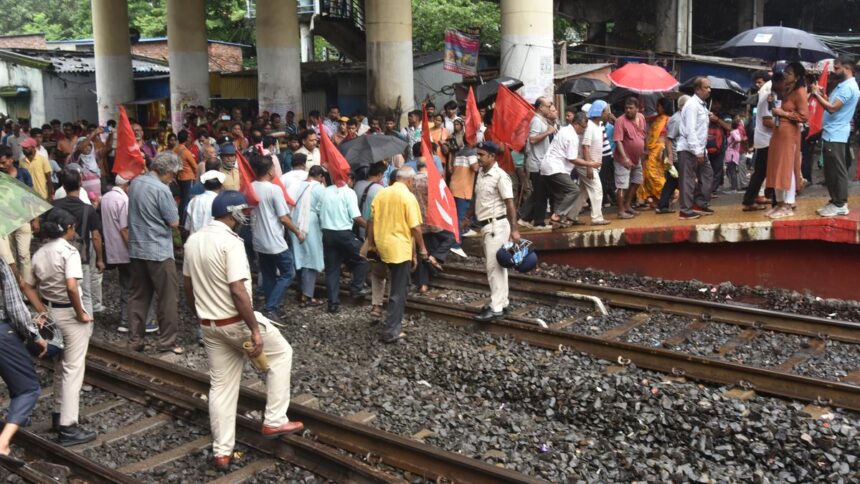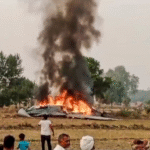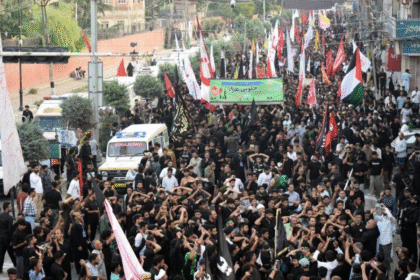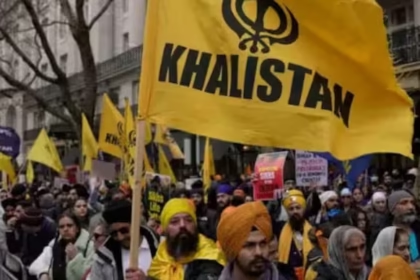Bharat Bandh Today: Trade Unions Lead Nationwide Strike on July 9, 2025 — Live Updates
The Pulse of a Nation on Strike
As India woke up on the morning of July 9, 2025, it wasn’t to the hum of regular traffic or the rhythm of everyday commerce. Instead, it was the silence of shuttered shops, empty railway platforms, and halted buses that defined the start of a massive, coordinated movement — Bharat Bandh, called by the nation’s central trade unions. For the millions affected, from commuters to business owners and daily wage laborers, this was not just another day of inconvenience. It was a defining moment in the nation’s socio-political timeline — a moment of dissent, defiance, and disruption.
The Bharat Bandh 2025, driven by widespread grievances ranging from labor law reforms and privatization concerns to inflation and unemployment, represents a significant expression of worker solidarity. The protest is supported by a coalition of national trade unions, student organizations, farmer bodies, and civil society groups.
In this multi-part deep-dive article, we’ll walk you through the layers of this movement — from what triggered the bandh, to the role of trade unions, state-wise participation, economic implications, live ground reports, and what it could mean for India’s future.
Why India is on Strike Today
The seeds of the Bharat Bandh 2025 were sown months ago, amid growing unrest among India’s working population. Several triggers converged into a common cause:
Labor Law Reforms: A Controversial Push
One of the primary grievances driving the bandh is the central government’s push to consolidate 44 labor laws into 4 labor codes — on wages, social security, industrial relations, and occupational safety. While the government argued that this would simplify compliance and improve ease of doing business, trade unions alleged that the move diluted worker rights, especially in terms of job security, collective bargaining, and union representation.
Privatization of Public Sector Units (PSUs)
Another flashpoint has been the ongoing disinvestment of PSUs. Unions have opposed the government’s strategy to privatize key national assets — from banks and oil companies to railways — claiming this will result in mass layoffs, erosion of job security, and commodification of essential services.
Inflation and Economic Hardship
India’s inflation rate has hovered uncomfortably high over the past year. Essential commodities — including food, fuel, and electricity — have seen steep price hikes. Combined with stagnating wages and increased unemployment, the economic pain has triggered widespread dissatisfaction, especially among daily wage earners, farmers, and middle-class families.
Informal Sector Crisis
India’s informal sector, which employs over 90% of its workforce, continues to struggle with post-pandemic recovery. The failure to introduce robust safety nets and increasing contractualization of labor have left millions vulnerable, fueling resentment.
Who is Behind the Bharat Bandh?
The strike is led by a broad coalition of central trade unions, supported by farmer groups, transport associations, and civil society organizations. Major unions participating include:
- All India Trade Union Congress (AITUC)
- Centre of Indian Trade Unions (CITU)
- Hind Mazdoor Sabha (HMS)
- Indian National Trade Union Congress (INTUC)
- Self-Employed Women’s Association (SEWA)
Student unions from major universities such as JNU, BHU, AMU, and Delhi University have extended solidarity. Farmer groups, including factions of the Samyukt Kisan Morcha (SKM), have also joined in select states, especially in Punjab and Haryana.
Bandh Day — Scenes from Across India
Delhi: Barricades and Slogans
In the national capital, hundreds of protesters gathered at Jantar Mantar, waving union flags and shouting slogans such as “Mazdoor ekta zindabad” and “Corporatization ka virodh karo.” Metro stations remained open but saw lower footfall. Several buses operated with skeletal staff.
Maharashtra: Mumbai Stands Still
In Mumbai, auto and taxi unions joined the bandh. While suburban trains — Mumbai’s lifeline — remained functional, ridership dropped. Several business hubs like Dadar, Andheri, and CST witnessed partial shutdowns. Educational institutions either declared holidays or shifted to online mode.
West Bengal: Strongest Response
West Bengal witnessed the strongest bandh response, with state government employees joining in large numbers. Kolkata streets were mostly empty by 11 am, and train and bus services were disrupted. Mamata Banerjee’s government, while not officially backing the strike, refrained from using force against demonstrators.
Tamil Nadu: Protests and Roadblocks
In Chennai, industrial workers blocked arterial roads leading to Sriperumbudur and Ambattur, demanding reversal of privatization policies. Police deployed in large numbers maintained relative peace despite the tension.
Government’s Response
The central government has termed the bandh as “politically motivated and economically disruptive.” In a statement issued by the Ministry of Labour and Employment, officials claimed that the labor reforms are “aimed at empowering workers, not weakening them.” They urged trade unions to engage in dialogue instead of street action.
Security was beefed up in major cities, with Section 144 imposed in parts of Delhi, Bengaluru, and Lucknow. Union leaders, however, remained defiant.
“The government has ignored our demands for too long. This is not just a strike, it’s a call for justice,” said Tapan Sen, General Secretary of CITU.
Impact on Economy and Daily Life
Transport
- Over 40% of state-run buses in states like Kerala, West Bengal, and Telangana were off the roads.
- Ride-hailing apps like Ola and Uber faced sharp surges in fare due to high demand and low supply.
- Several domestic flights experienced delays due to ground staff absenteeism.
Industries
- Manufacturing clusters in Gurugram, Pune, and Hyderabad reported reduced workforce presence.
- Factories in industrial belts either declared unofficial holidays or ran below 50% capacity.
Banking
Public sector bank branches, particularly in rural belts, remained shut. ATM services were limited in some areas due to logistic issues.
Schools and Colleges
While central institutions remained unaffected, many state-run schools and universities declared closures in support or due to safety concerns.
Voices from the Ground
“We’re not asking for favors. We’re demanding dignity, job security, and a future for our children,”
— Savitri Devi, sanitation worker, Kanpur
“My factory told us not to come today. They fear protests. But if we don’t fight now, there won’t be jobs left to protect.”
— Raju Yadav, garment factory worker, Ludhiana
“The strike inconveniences people, but so does losing livelihoods to privatization.”
— Sundar Rajan, union leader, Chennai
State-Wise Participation Map — Who Joined, Who Resisted?
The Bharat Bandh on July 9, 2025, saw uneven participation across India. Some states emerged as strongholds of resistance, while others witnessed muted or symbolic involvement. Below is a state-by-state breakdown of the strike’s intensity:
Strong Participation States:
- West Bengal:
With active support from trade unions and sectors like transport, education, and public service, Kolkata and other major cities witnessed near-complete shutdowns. Demonstrations were widespread but peaceful. - Kerala:
Known for its left-aligned worker movements, Kerala saw banks, shops, and public transport services halt. Government offices ran on skeleton staff. The state administration did not interfere with protests. - Punjab & Haryana:
Farmer groups affiliated with the Samyukt Kisan Morcha joined in, blocking highways like NH-44 and NH-1. Industrial hubs in Ludhiana and Ambala were significantly impacted. - Tamil Nadu:
Transport unions and industrial laborers held blockades across Chennai, Coimbatore, and Madurai. Left-backed student organizations also took part in campus protests.
Moderate Participation States:
- Maharashtra:
Mumbai remained partially operational due to the city’s financial commitments, but areas like Thane, Nagpur, and Nashik saw bus stoppages and union-led demonstrations. Banking unions participated, affecting PSUs. - Telangana:
Hyderabad reported partial disruptions. IT firms operated normally, but public transport and government staff turnout remained low. - Delhi:
Protests at Jantar Mantar were significant. Delhi Police enforced Section 144 in areas like Connaught Place and ITO, but metro services remained unaffected.
Low Participation or Resistance States:
- Uttar Pradesh & Bihar:
The BJP-ruled states maintained administrative continuity. The strike was least visible in major cities like Lucknow and Patna, where district authorities warned of disciplinary action against employees joining the bandh. - Gujarat:
Ahmedabad and Surat saw no significant disruptions. Industrial zones continued work, and law enforcement remained on high alert to prevent road blockages. - Northeast States:
Minimal participation. Manipur and Assam saw only token protests by fringe labor groups.
Political Reactions — The Ideological Divide
The Bharat Bandh reignited the ideological fault lines between India’s ruling BJP and opposition parties.
BJP:
The central government dismissed the strike as “anachronistic, disruptive, and politically motivated.” In a press briefing, Union Minister for Labour Bhupender Yadav stated:
“The government has passed historic labor reforms aimed at formalizing employment and improving social security. The bandh is a regressive tactic to stall national growth.”
Congress:
The Indian National Congress supported the strike, calling it a “wake-up call for the Modi government.” Party President Mallikarjun Kharge said:
“When laborers, farmers, students, and unions unite in protest, it shows something is fundamentally wrong with the government’s economic policies.”
Left Parties:
The CPI(M) and CPI were at the forefront of the movement. CPI(M) General Secretary Sitaram Yechury led a rally in Delhi and condemned the central government for “corporate appeasement and anti-worker legislation.”
Regional Parties:
- DMK (Tamil Nadu) and TMC (West Bengal) offered tacit support, allowing democratic protests without police interference.
- BJD (Odisha) and YSRCP (Andhra Pradesh) remained neutral, focusing on administrative stability.
How Corporate India Reacted
India’s private sector had mixed reactions to the bandh:
IT & Tech Sector:
- Bengaluru, Hyderabad, Pune: IT firms advised employees to work from home.
- Multinational corporations like Infosys, TCS, Accenture issued internal alerts about possible travel delays.
Banking & Finance:
- PSU banks like SBI, PNB, and BoB saw widespread absenteeism.
- Private sector banks — HDFC, ICICI, Axis — remained largely functional, especially in metro cities.
Manufacturing:
- Automotive and textile units in Gurugram, Noida, and Chakan (Pune) reported lower attendance.
- Some companies preemptively declared “maintenance holidays” to avoid clashes.
Logistics & E-Commerce:
- Services like Amazon, Flipkart, Blinkit experienced delays in Tier-2 and Tier-3 cities due to roadblocks and labor participation.
- Delivery agents in metros operated cautiously to avoid confrontation with protestors.
Bharat Bandh in Historical Context
India has a long tradition of general strikes or “bandhs”, often led by leftist trade unions or political coalitions. Here’s how this one compares:
| Year | Event | Scale | Key Issues |
|---|---|---|---|
| 2003 | All-India Strike by Left Unions | Moderate | Disinvestment of PSUs, pension reforms |
| 2016 | Central Trade Union Strike | Large | Minimum wage laws, contract labor exploitation |
| 2020 | Bharat Bandh by Farmers | Very Large | Farm laws, MSP guarantee |
| 2025 | Current Bharat Bandh | Nationwide, Mixed | Labor codes, privatization, inflation, job crisis |
What makes the 2025 bandh unique is its intersectional nature: it isn’t just about one law or one sector — it’s a convergence of grievances across labor, agriculture, education, and civil services, suggesting a broader societal discontent.
The Legal Debate — Right to Protest vs. Right to Movement
The bandh also reignited legal and ethical debates. Article 19 of the Indian Constitution guarantees the right to peaceful assembly. However, the Supreme Court, in past judgments (notably the 2018 case Mazdoor Kisan Shakti Sangathan vs Union of India), clarified that protests cannot infringe upon the rights of non-participants.
“Bandhs must not become tools of coercion,” said retired SC judge Justice Kurian Joseph, commenting on the July 9 bandh.
“A strike that respects both dissent and daily life reflects democratic maturity.”
The Global Lens — How the World Saw Bharat Bandh
International media also picked up the bandh’s scale:
- BBC described it as “India’s workers revolting against unchecked corporatization.”
- Al Jazeera ran a headline: “India Shuts Down in Protest — An Economic Uprising?”
- Bloomberg warned global investors of “short-term uncertainty amidst structural reform backlash.”
Global labor rights organizations, including IndustriALL and International Trade Union Confederation (ITUC), expressed solidarity, urging India to uphold ILO conventions.
Law and Order — The State’s Response on the Ground
While the Bharat Bandh 2025 was largely peaceful, scattered incidents of confrontation between protesters and police forces were reported in several states. Law enforcement, under pressure to maintain public order and prevent major service disruptions, responded with a mix of preventive detentions, force deployment, and crowd control tactics.
Delhi NCR: Pre-emptive Detentions
- In the early hours of July 9, Delhi Police detained over 80 union leaders from locations near Jantar Mantar, Rajghat, and Nehru Place, citing Section 151 of the CrPC (preventive arrest).
- Protesters alleged intimidation tactics, including night-time knocks at homes and “unofficial surveillance” of known activists.
- Several metro exits in sensitive zones like Central Secretariat and Janpath were closed temporarily to avoid mass mobilization.
West Bengal: Lathi-Charge in Howrah
In Howrah, an unpermitted road blockade by striking port workers led to a brief clash. Police lathi-charged demonstrators after they refused to disperse, injuring at least 17 protesters and 4 police personnel. The incident drew condemnation from CITU and AITUC, who accused the administration of using disproportionate force.
Uttar Pradesh: FIRs and Force
- In Kanpur and Varanasi, protest marches by student groups aligned with labor demands were disrupted by the police.
- Over 25 FIRs were registered against unnamed protestors under IPC sections 143 (unlawful assembly), 188 (disobedience to order), and 353 (assault on public servant).
- In Lucknow, a group of striking sanitation workers were forcefully removed from outside the Nagar Nigam building.
Tamil Nadu and Kerala: Passive Policing
- State governments in Tamil Nadu and Kerala instructed police to adopt a non-confrontational posture, leading to peaceful marches across Thiruvananthapuram, Coimbatore, and Madurai.
- Kerala’s DGP stated:
“We respected the right to dissent unless public safety was at risk.”
Stories from the Streets — Faces Behind the Flags
Beneath the banners and chants of “Inquilab Zindabad” were the lived realities of India’s working poor — resilient, vocal, and deeply aware of their role in the democratic machine. Here are just a few voices from July 9, 2025:
Rekha Bano, Anganwadi Worker, Bhopal
“I earn ₹7,000 a month. No EPF. No maternity leave. And now, with labor codes, they say we’re not even ‘formal employees.’ What is this if not betrayal?”
She marched for over 4 km alongside hundreds of other anganwadi and ASHA workers, demanding fixed wages and formal recognition under the new labor regime.
Ajit Pal Singh, Farmer from Karnal, Haryana
“Last year we fought for MSP. Now it’s the turn of the workers. A government that doesn’t listen will one day fall.”
He travelled with a 50-member farmer contingent, joining hands with striking industrial workers in Punjab and Haryana — echoing the agrarian–labor solidarity that had also defined the 2020–21 farm protests.
Mamta Yadav, Auto Driver, Mumbai
“The app companies keep our earnings. The petrol price eats our profits. And now they say we should work more to earn less?”
Part of the gig economy collective that formed during the pandemic, Mamta refused rides for the day and joined a joint protest with delivery riders, auto-rickshaw drivers, and metro workers.
Women at the Frontline
Unlike many past industrial actions, Bharat Bandh 2025 was notably women-led in sectors like:
- Healthcare: ASHA workers formed human chains in districts of Maharashtra, Bihar, and Odisha.
- Education: Government school teachers, particularly in West Bengal and Rajasthan, walked out en masse.
- Informal Sector: Beedi workers in Jharkhand and Chhattisgarh observed complete work stoppages.
Their demands weren’t limited to wages — they sought recognition, protection, and dignity.
Economic Fallout — What Did the Bandh Cost India?
While a full economic impact assessment will unfold over weeks, initial estimates suggest the Bharat Bandh 2025 caused significant disruptions:
Trade & Commerce Losses
- Retailers Association of India (RAI) estimated ₹4,200 crore in retail trade losses across Tier-1 and Tier-2 cities.
- The Confederation of All India Traders (CAIT) reported that around 60% of wholesale markets remained shut in Delhi, Kolkata, and Bengaluru.
Transportation Sector
- 50% of state buses in southern and eastern India didn’t operate.
- Estimated loss to urban transportation bodies (BEST, BMTC, etc.): ₹110 crore in one day.
- App-based aggregators (Uber, Ola) reported a 21% drop in ride volumes across affected metros.
Manufacturing & IT
- According to FICCI, daily losses in the manufacturing sector were pegged at ₹1,500 crore, especially in automobile hubs like Gurugram, Pimpri-Chinchwad, and Chennai.
- The IT sector, though less impacted, faced a dip in productivity by 7–10% due to absenteeism and disrupted commute.
Banking and Insurance
- Public Sector Banks operated at 40% capacity, resulting in transaction backlogs and cheque clearing delays.
- ATM cash replenishment was delayed in rural areas of Jharkhand, Assam, and Odisha.
Chapter 17: The Future of Trade Unionism in India
Changing Nature of Labor
India’s labor landscape is rapidly shifting:
- Formal jobs are shrinking, informal work is expanding.
- Tech is disrupting old hierarchies.
- Young workers are less unionized, but more digitally connected and mobilized.
This presents a challenge — and an opportunity — for unions to modernize, digitize, and diversify.
Political Relevance
Despite government attempts to marginalize unions as “nuisance groups,” the July 9 strike demonstrated enduring relevance, especially when backed by students, farmers, and informal workers.
Experts now predict a resurgence in class-based politics, particularly as India heads into the 2026 General Elections.
A Road Ahead
Union leaders have hinted at:
- A national convention in August 2025 to strategize further action.
- Possible sector-specific shutdowns (banking, telecom, logistics) in the coming months.
- Renewed efforts to challenge the labor codes in the Supreme Court.
Also Read : IAF Fighter Jet Crashes in Rajasthan’s Churu — 1 Pilot Ejects Safely, Investigation Underway







